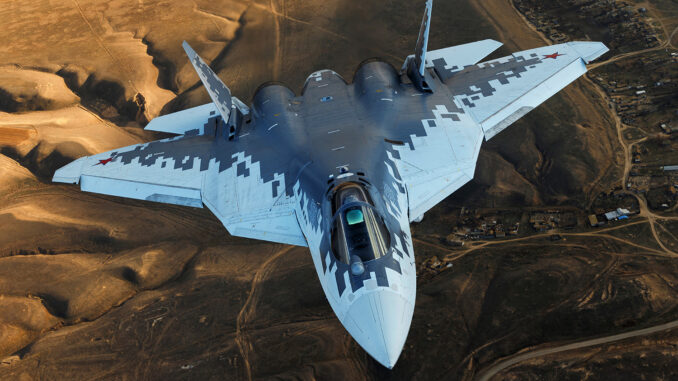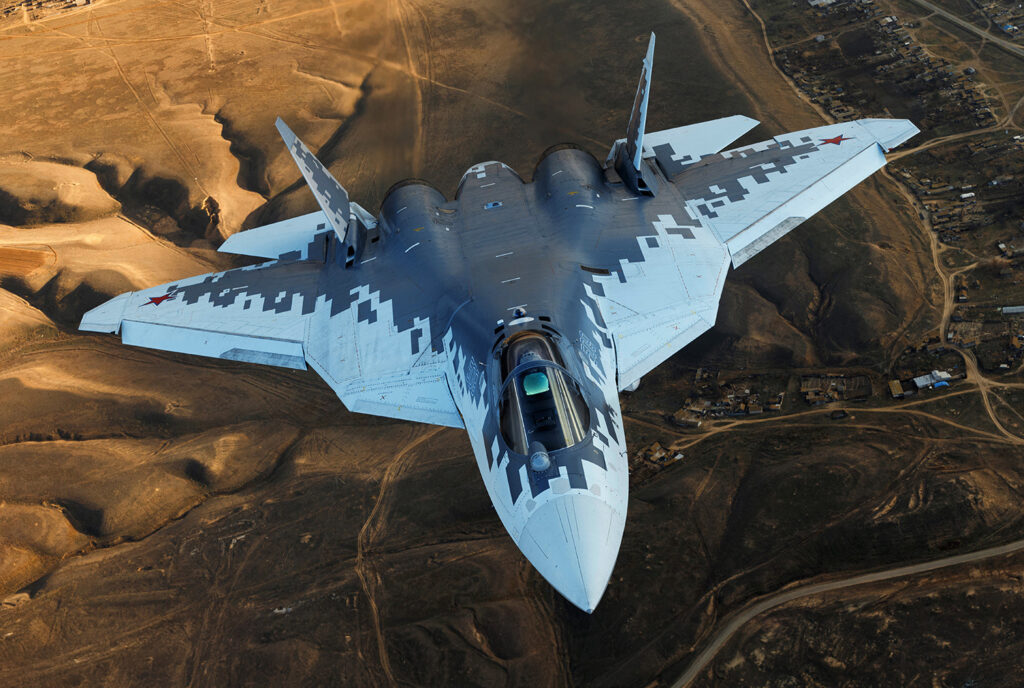
The Russian Su-57 is struggling to win over the international market because of sanctions, high costs and the complexity of the programme.
The Sukhoi Su-57, designed to be the spearhead of Russian military aviation, is struggling to find international buyers. Although promoted as a fifth-generation fighter, factors such as high costs, international sanctions (CAATSA) and a lack of transparency in development have led potential partners such as India to pull out of the project. In addition, complex relations with interested countries such as Algeria and Iran add further uncertainty to the future of the Su-57. This article looks in detail at these challenges and the export prospects for this aircraft.
The Su-57: A fifth-generation fighter under pressure
The Sukhoi Su-57, also known as the Felon, is the first fifth-generation fighter developed by Russia. With advanced features such as improved stealth, super-manoeuvrability and supersonic flight capabilities without afterburner, this aircraft was intended to compete with similar aircraft, notably the F-22 Raptor and the F-35 Lightning II from the United States.
However, despite these technological advances, the Su-57 encountered a number of difficulties that hampered its production and adoption. One of the main difficulties has been the cost of developing the aircraft, estimated at several billion dollars, and the complexity of its production, which has slowed down the delivery of units to the Russian army itself. In 2024, it was reported that the Su-57 suffered its first operational setback during a mission in Ukraine, where it was damaged by a drone attack. This kind of incident tarnishes the image of invulnerability that Russia seeks to project with this aircraft.
India’s withdrawal: a major blow to the Su-57 programme
Initially, the Su-57 project was to be a joint venture between Russia and India, with an agreement signed in 2007 for the joint development of a derivative version called the Fifth Generation Fighter Aircraft (FGFA). However, India pulled out of the project in 2018, expressing concerns about high costs, poor performance and a lack of transparency in the division of development tasks and benefits.
One of the main sticking points was Russia’s inability to provide fair information and technology sharing with India, as well as resistance to allowing Indian pilots to test the aircraft before finalising the specifications. In addition, India wanted a two-seat version of the Su-57 to meet its specific operational requirements, but Russia had neither the resources nor the will to develop this variant. The initial cost invested by India, estimated at 6 billion dollars (around 5.5 billion euros), was lost, marking a resounding failure for this partnership.
In addition to these internal challenges, the US Countering America’s Adversaries Through Sanctions Act (CAATSA) also acted as a deterrent, making it difficult for India to pursue significant military purchases with Russia without risking economic sanctions. India’s withdrawal has therefore left the Su-57 programme without one of its main financial and technological partners, exacerbating the project’s difficulties.

Algeria: an uncertain order
In 2020, it was reported that Algeria had placed an order for 12 to 14 Su-57s, with an option to increase this order to 24 units. Algeria, which has long enjoyed close military relations with Russia, reportedly saw the Su-57 as a way of strengthening its air capabilities against its regional rival, Morocco, which is largely supported by the United States.
However, since Russia’s invasion of Ukraine in 2022, the prospects for this order have become blurred. The economic sanctions imposed on Russia, combined with internal difficulties in producing the Su-57, have cast doubt on Moscow’s ability to honour this commitment. Moreover, the lack of recent official communication on this order suggests that the project may be on hold, or even cancelled.
This uncertainty highlights the challenges faced by countries seeking to purchase Russian military equipment in an increasingly tense geopolitical context. Algeria, which has often maintained an independent stance vis-à-vis the major powers, now finds itself in a complex situation where its defence needs must be balanced with international political and economic realities.
Iran’s interest: a hypothetical purchase
Iran has expressed an interest in the Su-57, but for the time being this interest remains hypothetical. In 2023, Iran finalised an agreement for the purchase of Su-35S, aircraft initially destined for Egypt but not delivered due to pressure from the CAATSA law. This purchase is seen as a preparatory step towards a possible acquisition of the Su-57, although this prospect remains uncertain.
Iran is currently under heavy international sanctions, which complicates any major military purchase. However, given its close relationship with Russia, it is possible that Iran may seek to acquire the Su-57 as a regional show of force. Iran currently operates ageing aircraft, including F-4 Phantom IIs and F-14 Tomcats, acquired before the 1979 revolution. The acquisition of the Su-57 would mark a significant modernisation of its air fleet.
However, it is important to note that relations between Russia and Iran have been historically complex. Despite increasing cooperation in recent years, particularly in the context of the war in Syria, Russia has refused to supply Iran with advanced weapons systems in the past. As a result, it remains to be seen whether the Su-57 will ever join Iran’s arsenal.
Consequences for the Russian and international aerospace industry
The Su-57 programme represents both a technical challenge and a symbol of Russian defence strategy. However, the difficulties encountered in the production and export of this aircraft highlight the limitations of the Russian defence industry in the face of economic sanctions and fierce international competition.
Russia, once a key supplier of fighter jets to the international market, has seen its market share dwindle, partly as a result of the sanctions imposed by the CAATSA law. Countries such as Egypt and Indonesia, which had expressed an interest in Russian aircraft, ultimately opted for Western alternatives, underlining the difficulty for Russia of maintaining its position in this market.
Looking ahead, Russia’s ability to sell the Su-57 to foreign customers will depend not only on improving the aircraft’s reliability and performance, but also on managing its geopolitical impact. Without solid international buyers, the Su-57 risks becoming a symbol of Russia’s unfulfilled ambitions in the field of military aeronautics.
What future for the Su-57?
The Sukhoi Su-57 remains a development project with an uncertain future. Technical challenges, financial constraints and geopolitical repercussions make it difficult to assess its potential success on the international market. Without strong international partnerships and the ability to overcome economic and diplomatic obstacles, the Su-57 may never find its place in the air fleets of foreign nations.
However, Russia may seek to redefine its defence strategy, focusing on partnerships with countries less affected by Western sanctions. The success of the Su-57 could then depend on Russia’s ability to adapt its offer to the specific needs of these nations, while resolving internal problems linked to the aircraft’s production and performance.
The Su-57 remains a project emblematic of the contemporary challenges facing the Russian defence industry, symbolising both the technological ambition and the geopolitical constraints facing Russia. The next few years will be crucial in determining whether this aircraft will become a pillar of global military aviation or whether it will remain a technical curiosity with no real strategic impact.
War Wings Daily is an independant magazine.